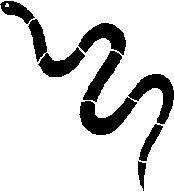|
The adult cottonmouth does not have any real enemies exept for
man and Linguatulid parasites. Some snakes have been found to
be parasitized by linguatulid, Porocephalus crotali, a
trematode worm that completely blocks the snakes glottis.
Another trematode know as Leptophullum tamiamiensis affects
the cottonmouths kidneys and females uterus. ( Howard K. Gloyd). The
Young are frequently eaten by egrets, ibises and small aligators.
Some of there predators include wading birds, horned owls, hawks,
eagles, alligators and there own species but these have been
reported to be minimal. The main cause of death in Agkistrodon
piscivorus is due to starvation.

Cottonmouths have several different anti-predator behaviors.
They are commonly viewed or expressed by humans as a very aggressive
snakes but this is probably due to the extreme anxiety or fear
people have toward most snakes in general. They
will commonly use the escape behavior, defensive posturing, tail
vibrations, musk release, mouth gapes, strikes and bites. The snake
more often than none will respond to threats by simply trying to
escape the path of its predator. It usually never responds with an
aggressive defense( bite, or strike) without first trying to escape
or using a passive behavior such that would warn, threaten, or
distract its predator. (Eric D. Roth & Joel A. Johnson) It has been
hypothesized that ant predator behavior varies with body size and
increases in body size were associated with a decrease in the level
of defensive responses. Research has also been conducted that shows
no difference in ant predator behavior between sexes.
BACK TO TOP
WEBSITE CREATED BY: Michael Connor
|


